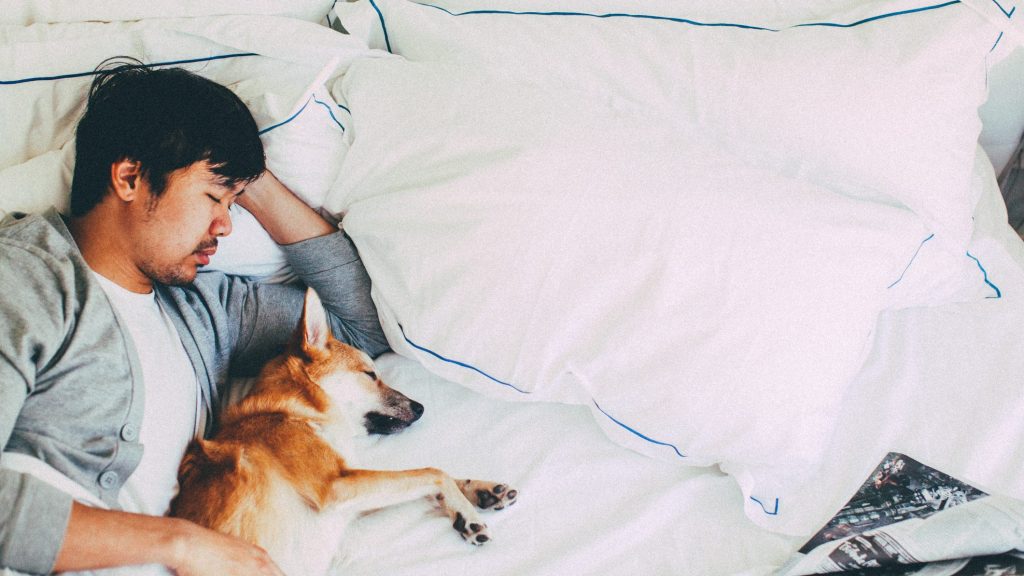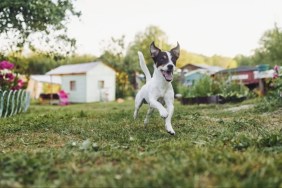Your dog’s sleeping position, the way they twitch or move, and the amount of time they spend napping can reveal a lot about how they’re feeling. Sleeping habits can give clues about a dog’s health and happiness that you can interpret if you know what to look for. Of course, if you spot anything unusual or different about your dog’s sleeping behaviors, you should get to the vet for a checkup. Here are a few things to take notice of when your dog is sleeping and what they might mean.
Dog sleeping positions

Pay attention to the position your dog sleeps in most frequently. Your dog’s favorite sleeping position might change based on where they’re snoozing, who they’re sleeping near, or if they’re feeling a certain way. Because injuries or soreness can cause a dog’s sleeping position to change, keep an eye out for signs of pain. Get to the vet if anything seems off.
Below are some common sleeping positions and what they might mean.
Supine position
The dog supine position refers to when a dog is lying on their back with their belly and underside exposed. So why do dogs sleep on their backs? Here are a few reasons:
- It’s a sign of comfort and trust – When dogs voluntarily flip onto their backs and expose their bellies, it shows they are fully relaxed and comfortable, letting their guard down. A dog only enters this position when they feel safe.
- Invitation for belly rubs – A dog rolling onto their back and showing their belly is often an open invitation for an owner to give them belly rubs and scratches. The belly is a sensitive area dogs don’t allow just anyone to touch, so this shows trust.
- Submission signal – Exposing the belly can also be a dog’s way of showing submission, communicating they are not a threat. It may be an appeasement behavior when they are being scolded or disciplined.
- Regulates temperature – Dogs can roll onto their backs to help cool down, pressing their underside to a cool surface. Belly up also exposes less fur to direct sunlight on hot days.
When a dog flips onto their back into the supine position, they are signaling trust, showing they are at ease, inviting affection, demonstrating submission, or just trying to beat the heat! It’s an important calming and communicative posture for dogs.
On the side
A dog who sleeps on their side feels safe and comfortable, as this position leaves the vital organs exposed. Dogs who favor this position tend to be pretty easy-going and relaxed. That said, they may switch to a different position if they’re sleeping somewhere new or around someone they aren’t familiar with. This position also leaves their limbs free to move during sleep, so you may see more twitching and leg kicks.
Curled up
A very common position dogs take when sleeping is to curl up in a ball. This is also called “nose-to-tail.” It’s a common position for animals to take in the wild, too. This position protects the vital organs, helps conserve warmth, and makes it easy to get up quickly. It restricts movement during sleep, so you may see less twitching from a dog who snoozes in a ball.
You might think that a dog who sleeps in this position would be uncomfortable in their surroundings. That’s not necessarily true. It’s a common position in the fall and winter months when the weather is cool. Also, it may just simply feel better for a particular dog to sleep in that position.
Sprawled out on the tummy
This is sometimes called the “Superman” position. It allows for a dog to pop up and be on their paws right away. You often see this position with puppies who need to nap frequently but also want to be ready to jump up and play at a moment’s notice. Dogs who sleep in this position don’t want to miss a chance to be in the action. It’s the position of choice for high-energy pups or pups who get sleepy during play.
Back-to-back or snuggled up
You may catch your dog sleeping back-to-back with your other pets or snuggling up to you. Either way, it means the same thing. Your dog is bonding and showing that they want to get close to you or their furry siblings. A dog sleeping this way feels very loving and affectionate, and they’re completely comfortable with whoever they’re napping with. Try showing your love in return by taking a snooze with your pup.
Sleeping behaviors

Once your dog is napping, you may get some clues about the quality of their sleep from their behavior. Sleep is important for healing and repairing the body, and REM sleep, which is the deepest stage of sleep, is the most restorative. Pay attention to these signs and behaviors to make sure your dog is getting the best sleep possible.
Circling and digging
It’s normal behavior for dogs to circle their sleeping area or even dig a bit before lying down for sleep. This is behavior that comes from dogs’ wolf ancestors who would often trample down grass, leaves, or snow to get comfortable. They might also dig a hole that would help keep them warm in winter or cool in summer. Though dogs tend to circle a few times before lying down, doing it too much or having trouble settling in might be a sign of pain, arthritis, or a neurological issue. Consult a vet if you notice excessive circling.
Light dozing
A dog might doze off during the day if they’re bored or just getting a rest. This is not a very restful sleep, and your dog may just be waiting for something more interesting to come along. Watch your pup’s ears and see if they perk up at any movement or unusual noise. This probably means that your dog is still fairly alert and looking for something worth getting up for. Maybe it’s time to do something fun like go for a walk or play fetch.
Twitching, wagging, or soft barks
Dogs tend to move a bit during REM sleep when they’re most restful. They could very well be acting out their dreams, but they are getting a nice, deep sleep. Twitching, tail wagging, leg kicks, and occasional barks or grunts are common. This is a good time to let sleeping dogs lie. This stage of sleep is very restorative and good for their health. Movement during sleep is actually more frequent in puppies and senior dogs for unknown reasons. Sometimes your dog will move from spot to spot while sleeping. A less common reason for twitching during sleep is if a dog is cold. The twitches are the body’s way of warming up. If your dog is cold, get a blanket or move them to a warmer sleeping place.
Signs of distress
Like humans, dogs can have nightmares. If your dog seems particularly agitated during sleep with more movement, barks, or whimpers than usual, you can try gently calming your pup down. Call their name softly and stroke their back or side. Use soothing tones. Your pup may wake up or may just simply relax and continue on with a more pleasant dream after you’ve comforted them. If you notice your dog frequently seems agitated during sleep, you may want to schedule a vet visit to be on the safe side.
Seizure
When twitching gets excessive, it could be a sign of a seizure that requires immediate medical attention. Try calling your dog’s name and waking them up if you suspect their movements are abnormal. If they wake up, it may have just been an intense dream. If they don’t respond to your calls, continue to shake, or feel stiff, get medical help right away. You should pay attention to your dog’s usual sleeping habits so you know the difference and can tell when something is out of the ordinary.
Why does my dog sleep against me?

There are a few key reasons why dogs commonly like to sleep pressed up against or in contact with their human owners:
- Comfort & security – Sleeping right against you brings feelings of warmth, comfort and security for your dog. Your presence next to them makes them feel protected and less anxious.
- Bonding – Being physically close while sleeping fosters bonding, attachment and trust between a dog and human caretaker. This skin-to-skin contact releases oxytocin, also known as the “love hormone.”
- Your scent – Your unique scent is soothing and familiar to your dog, while also letting them make sure you are close by. Sleeping against you allows them to inhale your scent and always know where you are.
- Warmth – Your body radiates heat that keeps your dog nice and cozy while they sleep curled up against you. Sharing body heat is appealing for warmth-loving canine companions.
- Pack mentality – Since dogs are pack animals, sleeping huddled together is natural. Being right against you fulfills their instinct to sleep as part of their pack for comfort and protection.
So in many cases, your dog sleeps pressed up on or very close beside you because it makes them feel safe, secure, loved and comforted – reflecting their natural tendencies as domesticated animals evolved to view their owners as family!
How much do dogs sleep?
Dogs sleep a lot more than people do. On average, dogs need about 12 to 14 hours of sleep a day. Big dogs tend to take longer naps than smaller dogs. Puppies can sleep about 12 to 20 hours a day, usually waking up for an hour after every few hours of sleep. Take notice of your dog’s normal sleeping habits. If you notice a change in how long your dog sleeps, it could mean a lot of things from a dietary change to a thyroid problem. If your dog is spending too much time napping, it could be time for a vet visit.









